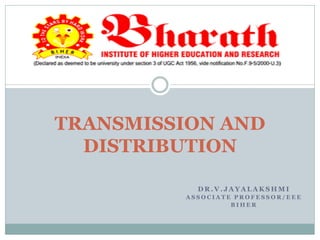
EEE- BEE601 - TRANSMISSION AND DISTRIBUTION- Dr. V. Jayalakshmi.pdf
- 1. D R . V . J A Y A L A K S H M I A S S O C I A T E P R O F E S S O R / E E E B I H E R TRANSMISSION AND DISTRIBUTION
- 2. SIMPLIFIED DIAGRAM OF POWER SYSTEM
- 3. A typical power generation, transmission and distribution system has these components: Power Generation Plants Substations Step-up Transmission Substation Step-down Transmission Substation Distribution Substation Underground Distribution Substation Substation Functions Substation Equipment Transmission Lines Overhead Transmission Lines Sub transmission Lines Underground Transmission Lines Distribution Systems Industrial Customer Commercial Customer Residential Customer Transportation Customer ELECTRIC SYSTEM COMPONENTS
- 4. Thermal Power Plant diagram Hydro Plant diagram Wind Power Plant Geothermal Power Plant Photovoltaic Power Plant POWER GENERATION PLANTS
- 6. SUBSTAION Substations are the places where the level of voltage undergoes change with the help of transformers. Apart from transformers a substation houses switches (called circuit breakers), meters, relays for protection and other control equipment.
- 7. Distribution System Between power stations and homes Reduce 60kV/30KV to 15, 10, 5KV
- 8. INSULATORS Transmission line insulators are devices used to contain, separate or support electrical conductors on high voltage electricity supply networks. Transmission insulators come in various shapes and types, including individual or strings of disks, line posts or long rods. They are made of polymers, glass and porcelain--each with different densities, tensile strengths and performing properties in adverse conditions TYPES OF INSULATORS Pin Type, Suspension Type Strain Insulator & Shackle Insulator.
- 9. PIN TYPE INSULATORS As the name suggests, the pin type insulator is secured to the cross arm on the pole. There is a groove on the upper end of the insulator for housing the conductor. The conductor passes through this groove and is bound by the annealed wire of the same material as the conductor. Pin type insulators are used for transmission and distribution of electric power at voltages upto 33 kV. Beyond operating voltage of 33 kV, the pin type insulators become too bulky and hence uneconomical.
- 10. SUSPENSION TYPE INSULATORS The conductor is suspended at the bottom end of this string while the other end of the string is secured to the cross-arm of the tower. Each unit or disc is designed for low voltage, say 11 kV. The number of discs in series would obviously depend upon the working voltage. For instance, if the working voltage is 66 kV, then six discs in series will be provided on the string.
- 11. STRAIN TYPE INSULATORS When there is a dead end of the line or there is corner or sharp curve, the line is subjected to greater tension. In order to relieve the line of excessive tension, strain insulators are used. For low voltage lines (< 11 kV), shackle insulators are used as strain insulators.
- 12. SHACKLE TYPE INSULATORS Shackle type insulators, similar to strain type insulators, are used on sharp curves, end poles and in section poles. However, unlike strain insulators, shackle insulators are designed to support lower voltages. These insulators are single, round porcelain parts that are mounted horizontally or vertically. In early days, the shackle insulators were used as strain insulators.
- 13. STAY TYPE INSULATORS Stay insulators, also called egg insulators, are primarily used to prevent stay wires from becoming energized from accidentally broken live wires. They, therefore, function to provide insulation between stay clamps and transmission poles. Stay insulators are mounted at a height of at least 3 meters (118 inches) from ground level.
- 14. UNDERGROUND CABLES An underground cable essentially consists of one or more conductors covered with suitable insulation and surrounded by a protecting cover. CABLE STRUCTURE
- 15. Advantages & Disadvantages Advantages Better general appearance Less liable to damage through storms or lighting Low maintenance cost Less chances of faults Small voltage drops Disadvantages The major drawback is that they have greater installation cost and introduce insulation problems at high voltages compared with equivalent overhead system.
- 16. Properties of Insulating Material High resistivity. High dielectric strength. Low thermal co-efficient. Low water absorption. Low permittivity. Non – inflammable. Chemical stability. High mechanical strength. High viscosity at impregnation temperature. Capability to with stand high rupturing voltage. High tensile strength and plasticity.
- 17. CLSSIFICATION OF CABLES • Low tension (L.T) ----- up to 1000V • High tension (H.T) ----- up to 11, 000V • Super tension (S.T) ---- from 22KV to 33KV • Extra high tension (E.H.T) cables --- from 33KV to 66KV • Extra super voltage cables ------beyond 132KV
- 18. Laying of Underground Cables The reliability of underground cable network depends to a considerable extent upon proper laying. There are three main methods of Laying underground cables a. Direct Laying b. Draw in system c. Solid system
- 19. Direct Laying This method is cheap and simple and is most likely to be used in practice. • A trench of about 1.5 meters deep and 45 cm wide is dug. • A cable is been laid inside the trench and is covered with concrete material or bricks in order to protect it from mechanical injury. • This gives the best heat dissipating conditions beneath the earth. • It is clean and safe method
- 20. Draw in System In this conduit or duct of concrete is laid in ground with main holes at suitable positions along the cable route. • The cables are then pulled into positions from main holes. Advantages of Draw in System It is very high initial cost Heat dissipation conditions are not good This method is suitable for congested areas where excavation is expensive and inconvenient This is generally used for short lengths cable route such as in workshops, road crossings where frequent digging is costlier and impossible
- 21. Solid System